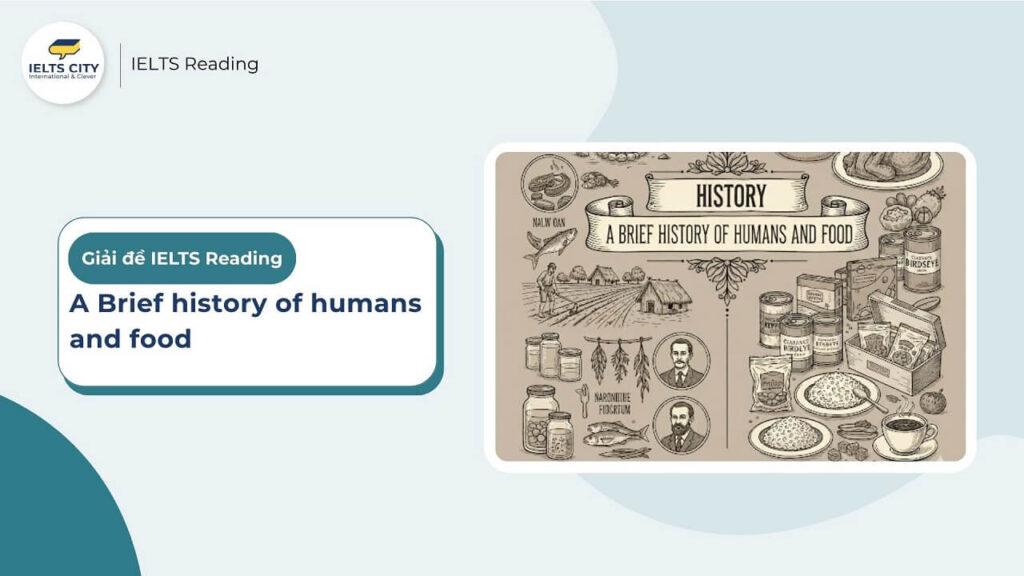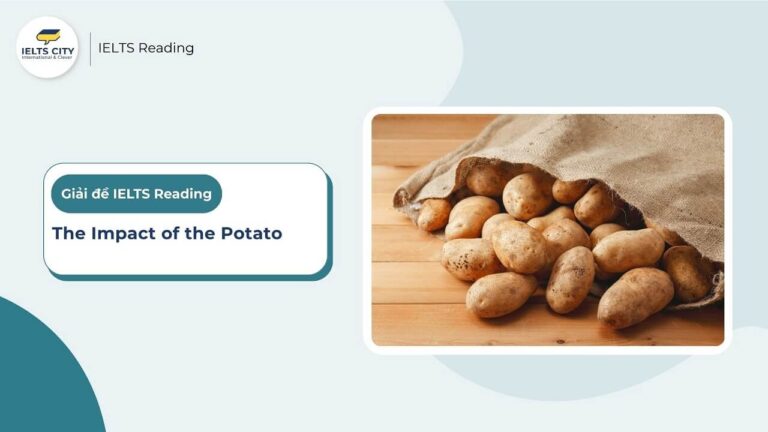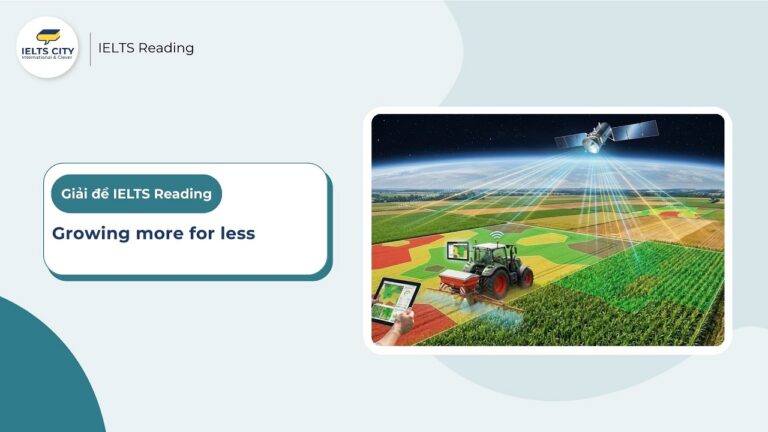
Nội dung chính
ToggleBài đọc
A Brief History of Humans and Food
During the journey from our hunter-gatherer ancestors to the present day, there have been three seismic changes that have impacted the food we eat: the discovery of cooking, the emergence of agriculture, and the invention of methods of preserving food.
The 19th-century scientist Charles Darwin thought that cooking, after language, was the greatest discovery made by man. All of us eat some raw food, such as fruit and vegetables, but the great majority of food we consume is cooked. Cooking can turn plants that are inedible into edible food by destroying toxic chemicals that plants often manufacture to protect themselves against attack by insects or other herbivorous animals. These toxic chemicals are referred to as “plant secondary compounds” because they are not directly involved in the plant’s normal growth, development, and reproduction, and are produced purely as chemical defenses. They give many of the plants we consume, such as coffee or Brussels sprouts, their bitter taste.
Cooked food is often more digestible because heat breaks down tough cellulose cell walls in plants or tough connective tissue in animals. Chewing raw turnip, a plate of uncooked rice, or a raw leg of lamb is much harder work than eating the cooked equivalent. The energy expended in chewing to break down the tough material is replaced by energy from the fuel used in cooking the food, so the ratio of energy gained to energy expended by the body is greater when food is cooked.
Until the development of agriculture, hunter-gatherers spent up to seven hours a day gathering food. This all began to change around 10,500 years ago with the advent of farming, which led to dramatic changes in human societies. People began to create a variety of new tools to aid survival, and in turn, populations increased in size. These changes led to the possibility of specialization of different tasks within society. Around this time, writing became more sophisticated and allowed people to maintain records of the harvest and taxes. Eventually, formalized structures of government were established as people settled in one area.
The arrival of agriculture meant that, for the first time, our ancestors had more food than they could eat immediately. This, combined with the seasonality of production, led them to discover methods of preserving food: smoking, drying, adding acid by fermentation, or adding salt. These four methods all share one feature in common—they make the food a more hostile environment for bacteria that can cause it to spoil. They also tend to slow down natural chemical reactions in the food that would cause decay.
Although foods today are still preserved in these ancient ways, two more recent methods of preserving food have become more common: canning and freezing. Canning was invented by a Frenchman, Nicholas Appert, in the early 19th century. He sealed food in bottles fabricated from glass and then heated them in boiling water to cook the contents. Appert’s method had great advantages over older methods of food preservation: it could be applied to a wide range of foods, and the flavor and texture were similar to freshly cooked products. His idea was soon copied by an Englishman, Peter Durand. Until this point, containers had been too heavy to be widely used, but Durand produced the first ones which were lightweight and resistant to damage. Two years later, in 1812, two Englishmen, Bryan Donkin and John Hall, started the commercial canning of food, although the real rise in popularity of canning had to wait until the invention of the can opener in 1855. Until then, cans were opened with a chisel and hammer. Canning is an extremely effective way of preserving food: one can containing meat, dating back to 1824, was opened in 1939, and the contents were still in good condition.
In the 21st century, the dominance of canning as a method of food preservation has been overtaken by freezing. Chilling food to keep it fresh is an old idea. The earliest mentions of icehouses, thick-walled buildings, half underground, date back to 1700 BC in northwest Iran. In early 16th-century Italy, water was mixed with chemicals to lower its freezing point to -18 degrees Celsius. Several centuries later, frozen fish and other goods were transported by ship from Australia to England. However, the modern frozen food industry was started in the 1920s by an American, Clarence Birdseye. While on a fishing trip with the Inuit in the Canadian Arctic, Birdseye observed that rapid freezing creates smaller ice crystals and therefore causes less damage to food—a discovery he had not expected. Nevertheless, the major growth in demand for frozen food came with the arrival of freezers in ordinary people’s homes. The advantages of frozen over canned food include the fact that the flavor and consistency are often identical to the fresh product, and freezing can be used to preserve a wide variety of foods.
Kiến thức cần nắm
Câu hỏi
Questions 1-5
Do the following statements agree with the information given in Reading Passage 1?
In boxes 1-5 on your answer sheet, write:
- TRUE if the statement agrees with the information
- FALSE if the statement contradicts the information
- NOT GIVEN if there is no information on this
- According to Darwin, cooking was the most significant development in human history.
- The process of cooking gets rid of some plant poisons.
- Eating cooked food is more energy efficient than eating raw food.
- Clarence Birdseye had previously worked in the Australian food industry.
- Birdseye’s trip with the Inuit confirmed what he already believed about rapid freezing.
Kiến thức cần nắm:
Questions 6-13
Complete the notes below.
Choose ONE WORD ONLY from the passage for each answer.
Write your answers in boxes 6-13 on your answer sheet.
The development of agriculture and food preservation
- The changes agriculture brought about were:
- The development of equipment and larger 6. _______
- The ability to keep 7. _______ as writing developed
- The setting up of organized government
Food Preservation
- Early methods of food preservation included:
- Smoking
- Acid or 8. _______
- Adding salt
- Canning
- Nicholas Appert put food into containers
- Appert’s method resulted in preserved food with the same taste and 9. _______ as fresh food
- Peter Durand introduced cans that were lightweight and 10. _______
- In 1855, the metal can opener replaced the 11. _______ and hammer used to open cans
- Some food was still edible after more than 100 years, e.g., an old can of 12. _______
- Freezing
- Rapid freezing prevents the formation of large ice crystals and causes less 13. _______
Kiến thức cần nắm:
Đáp án kèm phân tích
Questions 1-5: TRUE / FALSE / NOT GIVEN
1. According to Darwin, cooking was the most significant development in human history.
- Đáp án: FALSE
- Giải thích: Bài đọc nói rằng Darwin nghĩ nấu ăn là phát kiến vĩ đại nhất của con người, “sau ngôn ngữ” (after language). Điều này có nghĩa là Darwin coi ngôn ngữ là phát kiến quan trọng hơn. Do đó, việc nói nấu ăn là quan trọng nhất là sai.
- Vị trí và trích dẫn: Đoạn 2, câu 1.”The 19th-century scientist Charles Darwin thought that cooking, after language, was the greatest discovery made by man.”
2. The process of cooking gets rid of some plant poisons.
- Đáp án: TRUE
- Giải thích: Bài đọc nêu rõ rằng nấu ăn có thể biến thực vật không ăn được thành ăn được bằng cách “phá hủy các hóa chất độc hại” (destroying toxic chemicals) mà thực vật tạo ra. “Toxic chemicals” chính là “plant poisons” (chất độc thực vật).
- Vị trí và trích dẫn: Đoạn 2, câu 3.”Cooking can turn plants that are inedible into edible food by destroying toxic chemicals that plants often manufacture…”
3. Eating cooked food is more energy efficient than eating raw food.
- Đáp án: TRUE
- Giải thích: Đoạn 3 giải thích rằng năng lượng tiêu tốn cho việc nhai thức ăn sống được thay thế bằng năng lượng từ nhiên liệu dùng để nấu. Do đó, “tỷ lệ năng lượng thu được so với năng lượng cơ thể tiêu hao sẽ lớn hơn khi thức ăn được nấu chín” (the ratio of energy gained to energy expended by the body is greater when food is cooked). Điều này chính là hiệu quả hơn về mặt năng lượng.
- Vị trí và trích dẫn: Đoạn 3, câu 3.”…so the ratio of energy gained to energy expended by the body is greater when food is cooked.”
4. Clarence Birdseye had previously worked in the Australian food industry.
- Đáp án: NOT GIVEN
- Giải thích: Đoạn văn có đề cập đến Úc (Australia) trong bối cảnh cá đông lạnh được vận chuyển từ Úc đến Anh. Tuy nhiên, khi nói về Clarence Birdseye, bài đọc chỉ nói ông là người Mỹ và có chuyến đi đến Bắc Cực thuộc Canada. Hoàn toàn không có thông tin nào liên kết Birdseye với ngành công nghiệp thực phẩm của Úc.
5. Birdseye’s trip with the Inuit confirmed what he already believed about rapid freezing.
- Đáp án: FALSE
- Giải thích: Câu này cho rằng chuyến đi đã xác nhận điều Birdseye tin từ trước. Tuy nhiên, bài đọc lại nói rằng khám phá của ông về việc cấp đông nhanh tạo ra tinh thể băng nhỏ hơn và ít gây hại cho thực phẩm hơn là “một khám phá mà ông không hề mong đợi” (a discovery he had not expected). Điều này trái ngược hoàn toàn với nhận định.
- Vị trí và trích dẫn: Đoạn 7, câu 5.”…Birdseye observed that rapid freezing creates smaller ice crystals and therefore causes less damage to food—a discovery he had not expected.”
Đăng ký nhận tư vấn miễn phí
Ưu đãi học phí lên đến 40%
& Cơ hội nhận học bổng trị giá 2.000.000 VNĐ
Đăng ký nhận tư vấn miễn phí
Ưu đãi học phí lên đến 40%
________
Questions 6-13: Summary completion
6. populations
- Giải thích: Đoạn 4 nói rằng sau khi nông nghiệp ra đời, “dân số đã tăng lên về quy mô” (populations increased in size).
- Vị trí và trích dẫn: Đoạn 4, câu 2.
7. records
- Giải thích: Đoạn 4 đề cập rằng chữ viết phát triển đã cho phép con người “duy trì các ghi chép về mùa màng và thuế” (maintain records of the harvest and taxes).
- Vị trí và trích dẫn: Đoạn 4, câu 3.
8. drying
- Giải thích: Đoạn 5 liệt kê các phương pháp bảo quản ban đầu, cụ thể là “hun khói, phơi khô, lên men bằng axit, hoặc thêm muối ” (smoking, drying, adding acid by fermentation, or adding salt).
- Vị trí và trích dẫn: Đoạn 5, câu 2.
9. texture
- Giải thích: Đoạn 6 nói về phương pháp của Appert, cho rằng hương vị (“flavor”) và “kết cấu” (texture) của thực phẩm được bảo quản tương tự như sản phẩm mới nấu.
- Vị trí và trích dẫn: Đoạn 6, câu 3.
10. resistant
- Giải thích: Đoạn 6 nói rằng Peter Durand đã sản xuất những chiếc hộp đầu tiên vừa nhẹ vừa “chống hư hại” (resistant to damage).
- Vị trí và trích dẫn: Đoạn 6, câu 4.
11. chisel
- Giải thích: Đoạn 6 mô tả rằng trước khi có dụng cụ mở hộp, người ta phải dùng “cái đục và búa” (a chisel and hammer).
- Vị trí và trích dẫn: Đoạn 6, câu 6.
12. meat
- Giải thích: Đoạn 6 đưa ra ví dụ về một hộp đồ ăn từ năm 1824 vẫn còn tốt khi mở ra vào năm 1939, bên trong hộp đó chứa “thịt” (meat).
- Vị trí và trích dẫn: Đoạn 6, câu 7.
13. damage
- Giải thích: Đoạn 7 giải thích khám phá của Birdseye rằng việc cấp đông nhanh tạo ra các tinh thể băng nhỏ hơn và do đó gây ra ít “hư hại” (damage) cho thực phẩm hơn.
- Vị trí và trích dẫn: Đoạn 7, câu 5.
Cập nhật đề thi thật Reading mới nhất tại:





















